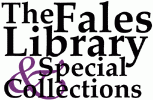Mark Bloch Postal Art Network (PAN) Archive
Call Number
Date
Creator
Extent
Language of Materials
Abstract
Mark Bloch (born 1956) is an American artist and writer who uses visuals and text to explore ideas of long-distance communication. In 1978 he founded the Postal Art Network (PAN) and began to use international postal services to distribute and receive art and connect with artists, art groups, institutions, and cultural workers from all over the world. The bulk of this collection, which spans from 1971 to 2009, consists of mail art sent to Bloch by correspondents in all fifty American states and dozens of countries. Examples of mail art in this collection include objects, postcards, enclosures, xerox prints, and collages, as well as serials and announcements documenting avant-garde cultural activities in various media. Additionally, this collection also includes books, personal materials that document Bloch's life, and what was deemed "junk mail" by Bloch.
Biographical Note
Mark Bloch is an American fine artist and writer who uses visuals and text to explore ideas around long-distance communication. Bloch was born in 1956 in Würzburg, Germany, where his father was based as a soldier of the US Army, and grew up in the suburbs of Cleveland and then Akron, Ohio. Bloch attended Kent State University, where he received his B.A. degree in broadcasting. In 1977, after studying traditional art forms as well as performance and video art, Bloch discovered the international mail art network and began to correspond with key figures in that movement.
Mail art is a movement developed by Ray Johnson and the Fluxus Group in the 1950s that involves the use of the postal service for the dissemination of artwork in order to circumvent official art distribution centers such as museums, art markets, and galleries. From 1978 to 1982 Bloch lived in Southern California and supported himself by making slide shows for corporate clients in the audiovisual industry. Bloch founded the Postal Art Network (PAN) in 1978 and began to correspond with the international network of mail artists originally established by Ray Johnson, later known as the New York Correspondence School. Bloch moved to New York in 1982 and became a member of Ray Johnson's New York Correspondence School. Bloch used the international postal system as a distribution network for his art and reached out to thousands of artists and cultural workers all over the world. In 1989, Bloch began his experimental foray into the digital space when he founded Panscan, part of a text-based teleconferencing system, the first online art discussion group in New York City. Bloch continues his work with mail art and related concepts online.
Scope and Content
The Postal Art Network (PAN) Archive consists of materials amassed by Mark Bloch, the founder of PAN and participant in the mail art movement. The collection documents the evolution of the mail art, Bloch and other artists' works, national and international avant-garde cultural activities, and parts of the global arts scene throughout the 1980s, 1990s, and early 2000s. Movements and artistic styles represented include Fluxus, Neo-Dada, Neo-Futurism, and Neoism. The PAN Archive also reflects the experimental circumvention and strategic navigation of mainstream cultural institutions in favor of the Do It Yourself culture of the late 20th century. Spanning from 1971 to 2009, the majority of the items in this collection are samples of original mail art or correspondence pertaining to it, sent to Bloch by artists, art groups, and institutions in all 50 states and dozens of countries. Said items include collages, paintings, drawings, Xerox artwork, stamp artwork, and invitations for mail art project participation. There are also non-mail art periodicals, announcements and flyers he gathered for over four decades, serials, and books. Additionally, materials include personal documents and correspondence Bloch deemed junk mail.
Some items in this collection contain profanity, sexually explicit, and violent content.
Subjects
Conditions Governing Access
Materials are open without restrictions. Please contact the Fales Library and Special Collections, fales.library@nyu.edu, 212-998-2596.
Conditions Governing Use
Copyright (or related rights to publicity and privacy) for materials in this collection was not transferred to New York University. Permission to use materials must be secured from the copyright holder. Please contact the Fales Library and Special Collections, fales.library@nyu.edu, 212-998-2596.
Preferred Citation
Published citations should take the following form:
Identification of item, date (if known); Mark Bloch Postal Art Network (PAN) Archive; MSS 170; box number; folder number; Fales Library and Special Collections, New York University Libraries.
Location of Materials
Provenance
Purchased from Mark Bloch in 2005; the accession number associated with the gift is 2005.170.
About this Guide
Processing Information
Collection was processed between 2008 and 2015 by Kelsi Evans, Lawrence Giffin, Nicholas Martin, Rhyannon J. Rodriguez, Laurainne Ojo-Ohikuare, Rachel Greer, and Sana Masood. Donor Mark Bloch advised on some arrangement decisions.
In November 2020, objects in Series III were rehoused by conservators to better protect the items.
Between January and May 2022, Camila Aguirre, a student enrolled in the Archives and Public History program at NYU, rehoused and amended the description of Series I to improve intellectual access to the materials and address preservation issues. She completed this work as part of a Capstone Project for HIST-GA 3013: Research in Public History and Archives. She consolidated Series I's "Subseries A: Correspondence (General Mail Art)", "Subseries B: Postcards", "Subseries C: Empty Envelopes," and "Oversize Series I: Correspondence" to reflect that all materials are mail art and do not need to be intellectually arranged by size or format. The series was fully rehoused to better facilitate long-term preservation and was arranged and described at the file level.
